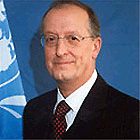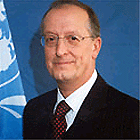United Nations Office on Drugs and Crime Executive Director Antonio Maria Costa arranged a study visit to Amsterdam on 24 April, during which he visited coffeeshop De Dampkring (the Atmosphere) and a user room (for inhalation and injection of heroin and cocaine), accompanied by two or three collaborators from UNODC, and high officials of the Netherlands Ministry of Health and of the City of Amsterdam.
Source: ENCOD
At the IHRA conference in Barcelona, at the NGO-session on 15 May, ENCOD’s Fredrick Polak asked him what he had learned from his trip to Amsterdam.
Costa said it had confirmed his views, and he announced a discussion paper that would be published shortly on the UNODC website. From this paper he could already disclose one important element: he claimed to have found that addiction rates to cannabis in Amsterdam are the highest in the world, three times higher than in other large cities.
This caused amazement all around.
Now we are in tense anticipation of, and phantasizing about Costa’s evidence selection and construction effort, to support this claim.
We received the following text from a source that wanted to remain anonymous. It was sent to us with this subject title: “ Amsterdam blog Mon 27 April 08.doc” .
Interestingly, our source said this text was copied from Costa’s Corner on the UNODC website, but we haven’t been able to find it there.
There are rumors that Costa presented a report on his Amsterdam visit to his host, the Netherlands Ministry of Health, and that this report was considered unacceptable, and refused. So it may be that this blog was indeed posted in Costa’s Corner but retracted after a few days.
Amsterdam: City of Tolerance is Tightening the Rules
Amsterdam is famous for its business wealth, world-class museums, canals, ubiquitous bicycle riders and care-free lifestyle – as well as for its red light district and marijuana coffee-shops. Since my Office is responsible for drug control and crime prevention (including fighting human trafficking), I decided to learn more about the facts – rather than the myths – surrounding the cannabis and sex trades in this wonderfully unique city. Thanks to the generous hospitality of Mayor Job Cohen and his staff, with colleagues from the Office I made a study tour of the city, with a full programme of meetings, lectures, presentations and on sight visits.
Back in Vienna, so many images of this fascinating city stick in my mind: the beautiful Rijksmuseum, the phantasmagoria of tulips, the historic bridges and the richly decorated houses overlooking the canals. But also the sights and the smells of drug coffee shops, especially the one I was invited to visit (featured in the movie Ocean’s 12). Its jolly owner — who said (and one could tell) he had personally tested all his products — proudly showed me a colourful marijuana menu, that he compared it to a wine list, emblazoned with colourful graphics and vivid jargon. On offer were hashish products, ranging from the expensive Dutch-produced full and rich Water Works (at 50 euro a gramm) recommended only to experienced smokers, to the cheaper black Lala Hasna from Morocco, graded very strong stoned. There were also varieties of marijuana like the very strong, clear high Mexican Haze, the sweet & fruity Love Potion no. 5, and a cheap mellow & spicy Laughing Buddha.
That was about drugs. What about sex?
Equally unforgettable were Amsterdam’s sex windows (450), its brothels (30) and escort agencies (120). I recall, just facing our boat’s embarcadero, one house with 3 such windows and as many scantly clad prostitutes soliciting their bodies – right next to a kindergarten, and across the street from one of Amsterdam’s most beautiful churches. Throughout the red light district a great variety of skin colours, ages, sizes and shapes were on offer (apparently there are around 8,000 sex workers). I cannot say much about the prices and types of services as we did not walk into any of these joints or speak with any of the women for rent, but the sex market seemed thriving. More than once I saw male clients, after some hesitation in front of the merchandise on display (sorry: in front of the girls), walk in – and the window curtain immediately pulled shut.
A libertine city?
Despite its reputation, the Netherlands does not actually have a tolerant drug policy. Law enforcement is tough. There are increased efforts to hit drug traffickers and confiscate their assets: the city’s enormous Schiphol airport has long maintained a zero-drug tolerance on passengers, crews, cargos and even aircraft. Throughout the country, there are plenty of measures (even coercive) to address the health of drug addicts. Spending on drug control is by far the highest in Europe (almost 0.7% of GDP). As a result, the Netherlands has below EU-average annual prevalence rates of cocaine, opiate, and amphetamine use. The percentage of people (aged 15-65) who consume cannabis at least once a year (5.4%) is above the global average (3.9%), though much lower than, say, Spain and Italy (11.2%) or Canada (17%).
Note, however, that despite the high budget expenditure (much larger than even in Sweden, where 0.47% of GDP is spent in drug control), the prevalence rate of cannabis use in the Netherlands is greater than in Sweden (3.1%). Is it that tolerant attitudes on the ground (i.e. at the municipal level) reduce the impact of otherwise uniquely high drug-related national budget expenditure?
A convincing model?
Of course, a closer scrutiny of the drug prevalence numbers, their causes and implications is needed, and we are undertaking it at UNODC. A few facts struck me, however. First, the marijuana coffee shops concept is logically flawed, as owners buy the drug illegally in bulk from traffickers and then sell it legally at retail. Second, these are licensed shops that sell an internationally controlled (i.e. illicit) drug: hence the complaints from neighbouring countries that drug tourism is encouraged. Third, as the EU smoking ban in public places comes into effect on 1 July, Dutch citizens will face the bizarre situation of being allowed to smoke a cannabis joint, but not allowed to smoke a cigarette in a coffee shop. Does all this make sense to you?
Why such a tolerant attitude towards cannabis?
We asked, and were told, that in 1976 the Netherlands passed an updated Opium Act that bans drug use (in line with the UN drug control Conventions). The Act makes a distinction between hard and soft drugs, although neither is legal (the soft/hard distinction is not sanctioned in the UN Conventions). Nevertheless, and following a policy of gedoogbeleid (tolerance), marijuana coffee shops – which, according to the International Narcotics Control Board violate the UN Conventions – are allowed to sell cannabis under specific conditions (no more than 5 grams per person, no patrons under the age of 18, no more than 500 grams kept in the coffee shop, etc). The goal, as described to me, is to separate the market between more and less harmful drugs, curb street dealing of cannabis, and keep its users in the mainstream of society.
What are the results?
A fundamental principle in economic science is that supply and price of a product affect its demand. With cannabis legally and plentifully available, its use is much higher in Amsterdam (almost 3 times more) than in the rest of the country (note: 80% of Dutch municipalities do not allow the sale of marijuana). Furthermore, in Amsterdam marijuana consumption is well above EU averages – and these figures do not count the tourists. An urban problem? Hardly so: there is no difference in the rates of marijuana use between London and the rest of the UK, or between Washington DC and the rest of the USA. Elsewhere in the world, the urban setting does not affect drug consumption rates: why should it affect Amsterdam? To conclude, the city has a health problem caused by marijuana availability, and this could get worse as cannabis becomes more potent.
We asked plenty of questions, and were given lots of information from open, friendly and well-prepared experts, willing to engage in debate in a most courteous and constructive way. Everything that we learned, and the conclusions we shall draw from it, will add to UNODC’s research on different approaches to drug control around the world.
Tightening the rules
Most importantly, we were told that Amsterdam is taking measures to reduce the number of coffee shops and sex clubs, to reflect policy and attitude changes about both. Country-wide, the number of coffee shops has dropped by a third in the past decade: the number of people seeking treatment for cannabis-related health problems has doubled in the same period. (Note: there were 729 coffee shops in the Netherlands in 2005, of which 226 are in Amsterdam.) We were told that the downward trend will continue. Tougher actions are also envisaged against people involved with drugs who cause public nuisance. I was happy to visit a care centre for addicts, serviced by dedicated staff with big hearts and an extraordinary sense of friendship.
We were told that the government is also contemplating a ban on grow-shops and magic mushrooms, and is moving marijuana coffee shops farther away from schools. (Note: the Maastricht town council is even looking at ways of restricting access to marijuana shops to residents, as a way of preventing drug tourism and related complaints by neighbours). I was also interested to hear that the government plans to publish a comprehensive evaluation of the national drugs policy in spring 2009, that will “look at the effectiveness of the policy of tolerance, make a risk assessment of the damaging effects of cannabis, and focus attention on the social impact of drugs.”
What about the sex trade?
All over the world the drug and the sex trades go together, often accompanied by violence and crime: hence former Secretary General Kofi Annan’s decision to established UNODC (in 1997) to deal with them all. Not surprisingly Amsterdam is also tightening policy regarding sexual exploitation and prostitution (which has been legal since 2000: the only city in the world). The municipality is carrying out large scale urban renewal in parts of the red light district. One of the more striking projects is to buy up canal-front properties formerly used as brothels, and rent them out to fashion designers. It is a bit eerie, yet effective, to see well-dressed mannequins (from top designers) in the same windows that until recently exhibited undressed women. Still, the city admits to problems in combating human trafficking and the booming escort services (Note: the latter have doubled since 1999 and now employ 1000-1200 women and men).
We visited a newly opened counselling centre for prostitutes. I was impressed by the efforts social workers are putting into remedial actions to rescue victims of human trafficking who are trapped in rooms not much bigger than the size of a bed, behind oversized street windows.
A hunch and a wish
Amsterdam deserves credit for its focus on evidence-based policy on drugs and sexual exploitation – and for the wisdom to adapt local regulations as needs arise.
My hunch is that the progressive tightening will continue and address the health risks of increasingly potent cannabis (its psycho-active component, THC, is more than 15%, as against the 2-3% when I was a Berkeley flower kid). It is also looking at better protection of the increasing number of trafficked women. My wish is to see this process of change well documented so that, first, the myths about Amsterdam’s drug and sex trades are dispelled and, second, useful lessons are learned by other administrations.
PS: Mayor Job Cohen is not elected (he is government-appointed) and I’m not a Dutch citizen. Should these two impediments be removed, next time around I would vote for him.




 Creative Commons Attribution
Creative Commons Attribution